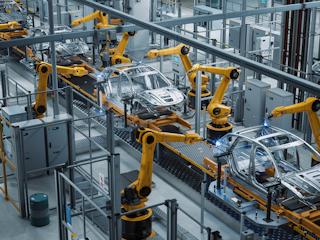It’s been a difficult few years for manufacturers. After a dramatic plunge in industrial output during the early stages of the pandemic, there was little time for respite, as enterprises then found themselves grappling with new supply chain disruptions born of global geopolitical challenges.
At the same time, manufacturers today find themselves struggling to navigate the dual challenges of rising operational costs and growing pressure to digitally transform. All the while, customer expectations continue to evolve, with just-in-time and lean manufacturing being key priorities for the industry at large.
The state of manufacturing: Why action can’t wait
The perennial and ephemeral challenges facing manufacturers have left many operating as though they’re still in crisis mode. For some, it has become a habit. For others, it’s a result of external factors like investor pressure or ever-changing industry standards and regulations.
A natural reaction in the face of such uncertainty is to scale back on innovative projects to cut costs and keep the lights on. Now, it’s time to break out of that cycle to instead focus on longer-term innovation and growth.
Supply chain disruptions aren’t going away any time soon, nor is the need for improved sustainability and efficiency. Moreover, with technological innovation moving at break-neck speed, customer expectations are evolving and putting pressure on companies to broaden their commerce initiatives.
B2B manufacturers must adapt and secure their operations so they can continue to thrive through almost any crisis. Digital transformation is squarely at the heart of that process.
How digital transformation continues to drive change
Crises are often catalysts for innovation. The pandemic resulted in a permanent shift to hybrid work, enabled by cloud-based collaboration solutions, digital self-service platforms and a rise of new commerce channels.
Major geopolitical events and global trade wars have resulted in a resurgence in European manufacturing, as companies shift from offshoring to nearshoring to regain control over their supply chains. Again, digital innovation has proven a vital enabler in that endeavor by streamlining production efficiency while keeping costs under control.
For B2B manufacturing commerce, digital channels are only going to become more important. For example, online self-service and ecommerce portals can absorb some costs associated with traditional distribution channels while better meeting demand for greater transparency. For instance, global supplier of paints and coatings Hempel A/S plans to use connected digital systems to improve transparency around freight costs, thus giving customers similar shopping experiences to their B2C counterparts.
eLearning initiatives present another opportunity with potentially impressive returns. When you can provide customers with the knowledge and resources they need to get more out of your products, it’s all the likelier they’ll stay, boosting customer lifetime value (CLTV) in the process. For example, vegetable-breeding company Rijk Zwaan provides educational resources to help customers adopt better cultivation techniques.
Yet another opportunity born of digital transformation is the shift toward subscription models to create recurring revenue streams. This will only become more important as organizations invest in aftermarket services, such as maintenance and parts replenishment. For instance, industrial equipment providers can use ecommerce platforms to automate the reordering of parts so customers get what they need without the need for manual intervention.
Keeping up with growing customer demands
Digital transformation has had a profound impact on customer experience and expectations. B2B customer expectations are increasingly set by what they can do in B2C to the point that they don’t really distinguish between the two. In other words, B2B customers expect the same degree of convenience and self-service that they’re already used to in B2C.
This has made ecommerce a key enabler of growth in manufacturing. For example, automotive parts vendor D&W Diesel recently built an online store where auto repair shops, body shops and dealers can search quickly through more than 60,000 SKUs and purchase what they need online.
Of course, no two ecommerce initiatives look the same, and they can vary widely in how well they accommodate customer demands. The most effective strategies work by incorporating a broad range of customer touchpoints, both to provide personalized shopping experiences and to collect data for insight. For instance, global provider of hydraulics services HSR GmbH uses predictive analytics to gauge customer needs and deliver a more personalized and proactive service.
As is the case in any industry, manufacturers are no longer just selling products. They’re also selling experiences. Another way manufacturers can keep up with customer demand, while also reducing waste and cutting costs, is to offer flexible on-demand manufacturing services. These might allow buyers to customize products to their own specifications, as well as order smaller quantities without the delays commonly associated with mass production.
Closing the talent gap for future success
Digital transformation is a journey rather than a destination. Technological innovation doesn’t stop, so neither can your digital initiatives.
Still, there remains a widespread adversity to change in the manufacturing sector, which is due in part to a lack of sufficient training and employee development. This talent gap is one of the leading causes of failed digital strategies, resulting in increased risk across domains like quality control and information security.
There’s no denying that adopting new digital commerce channels and other initiatives adds complexity. It’s imperative that you have the right skills and expertise to keep technical debt to a minimum and ensure disparate systems and selling channels don’t end up being barriers to growth.
The problem is especially serious for smaller manufacturing companies, which simply don’t have the resources necessary to easily adopt ecommerce initiatives or implement the underlying infrastructure ecommerce requires.
To address the talent shortage challenge, manufacturers must invest both in upskilling their existing workforces and partnering with external vendors and agencies that understand the challenges facing the industry. After all, the reluctance to adopt new digital tools is rarely born of overt conservatism, but a lack of preparedness.
If you can overcome that by forming the right partnerships and by continuously developing your workforce, you’ll be one major step closer to levelling up your ecommerce initiatives and driving long-term success.
Are you ready to take the next leap in B2B manufacturing? Download Valtech’s latest report to explore actionable strategies and expert insights from four of Europe’s industry leaders.











